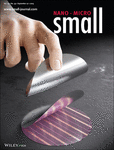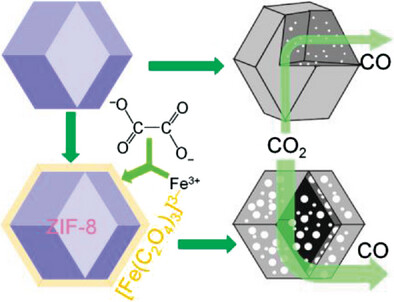Journal list menu
Export Citations
Download PDFs
Cover Picture
Ultrathin Crystalline Silicon Nano and Micro Membranes with High Areal Density for Low-Cost Flexible Electronics (Small 39/2023)
- First Published: 27 September 2023
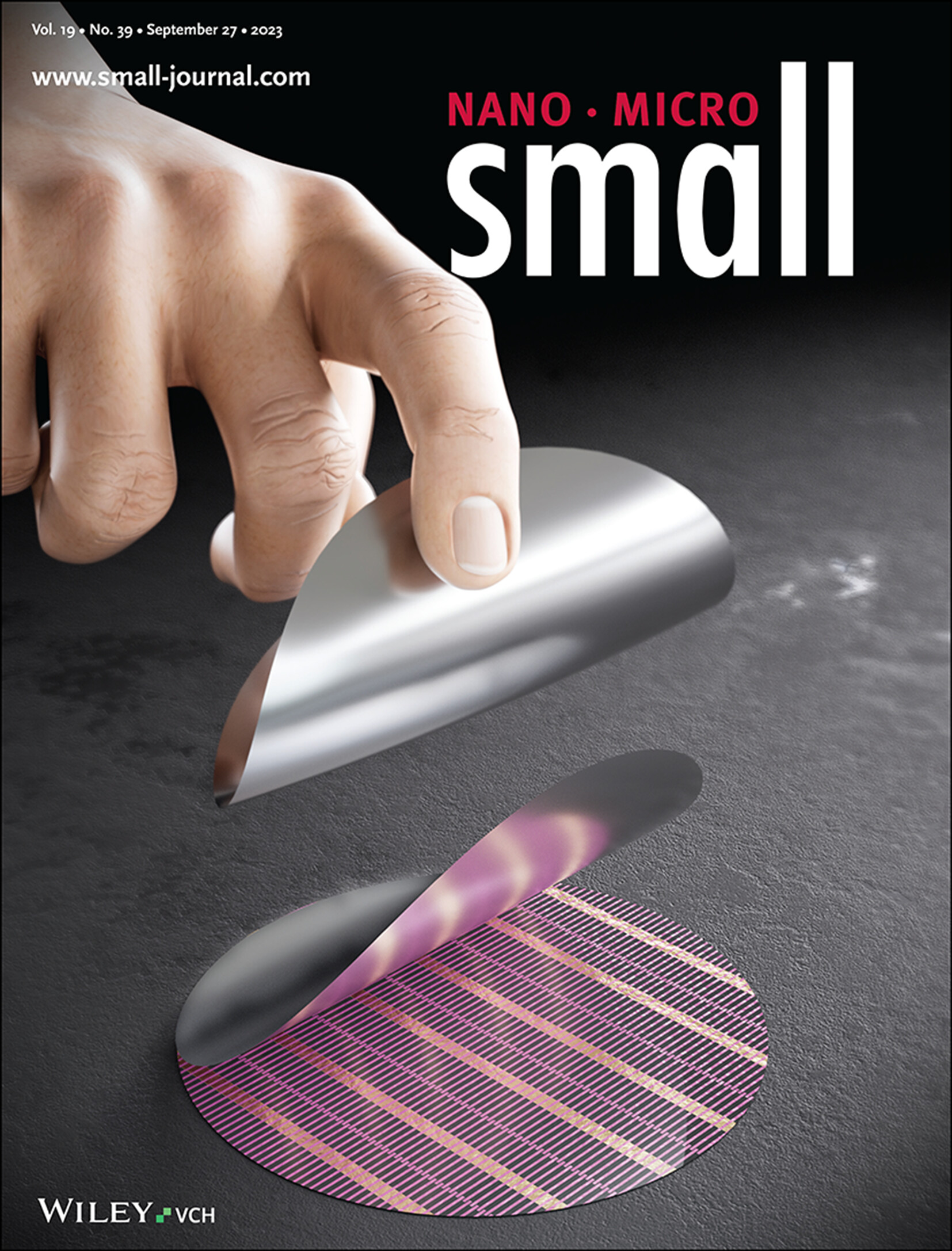
Low-Cost Flexible Electronics
Multiple generations of ultra-thin crystalline silicon nano/micro-membrane sheets with high areal density can be formed from a single <111> mother wafer using an unusual anisotropic etching technique, which can be utilized for various electronic applications in flexible electronic devices. More details can be found in article number 2302597 by Ki Jun Yu, John A. Rogers, and co-workers.
Inside Front Cover
Super-Macroporous Lightweight Materials Templated from Bicontinuous Intra-Phase Jammed Emulsion Gels Based on Nanochitin (Small 39/2023)
- First Published: 27 September 2023
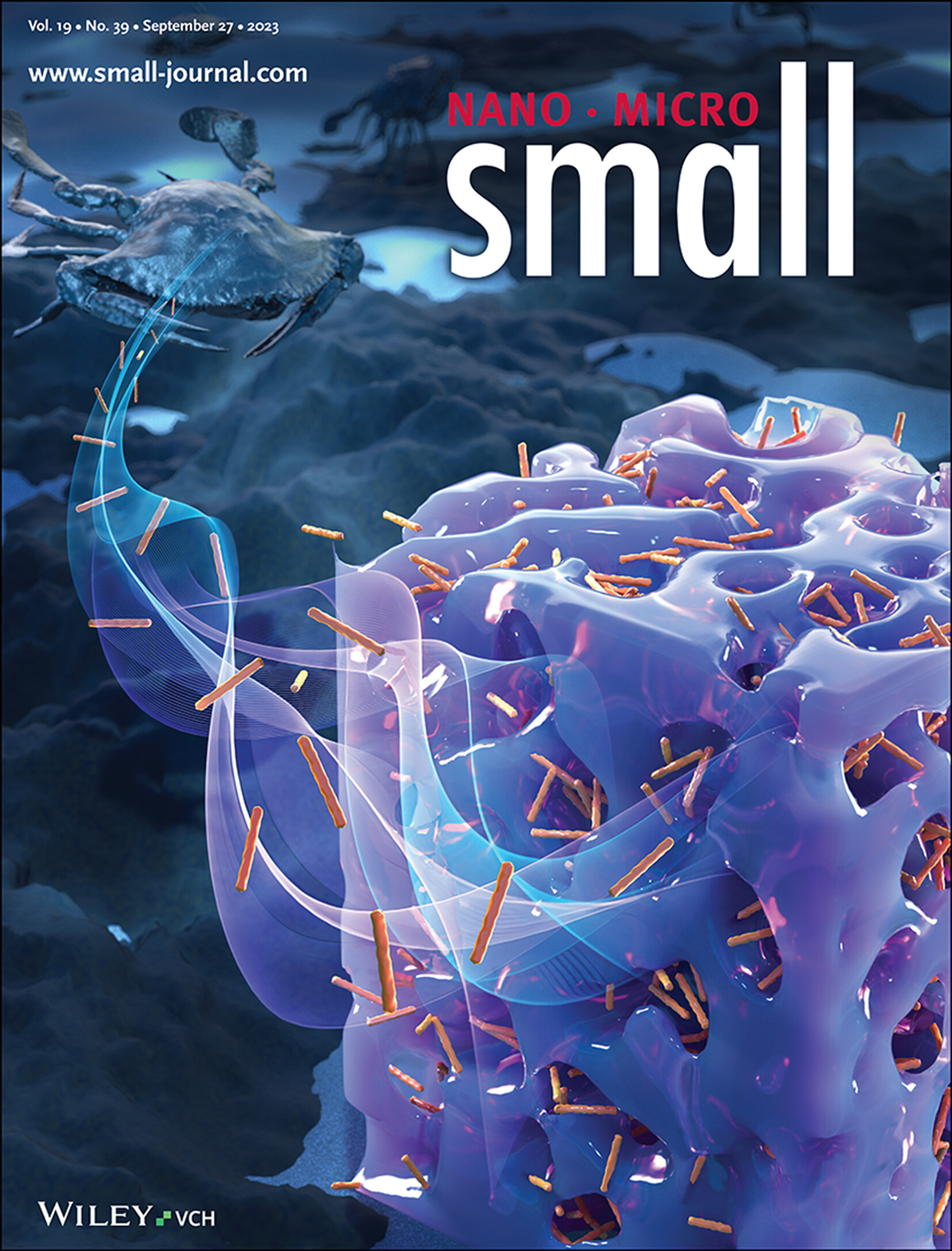
Chitin Nanocrystals
Chitin nanomaterials are extracted from crab shells to stabilize bicontinuous emulsions by intra-phase jamming at ultra-low concentrations. In article number 2300686, Long Bai, Orlando J. Rojas, and co-workers show the merits of bio-based nanoparticles in forming complex multiphase systems, offering a new pathway to achieve advanced hierarchical and multiscale materials.
Inside Back Cover
Morphology and Performance Enhancement through the Strong Passivation Effect of Amphoteric Ions in Tin-based Perovskite Solar Cells (Small 39/2023)
- First Published: 27 September 2023
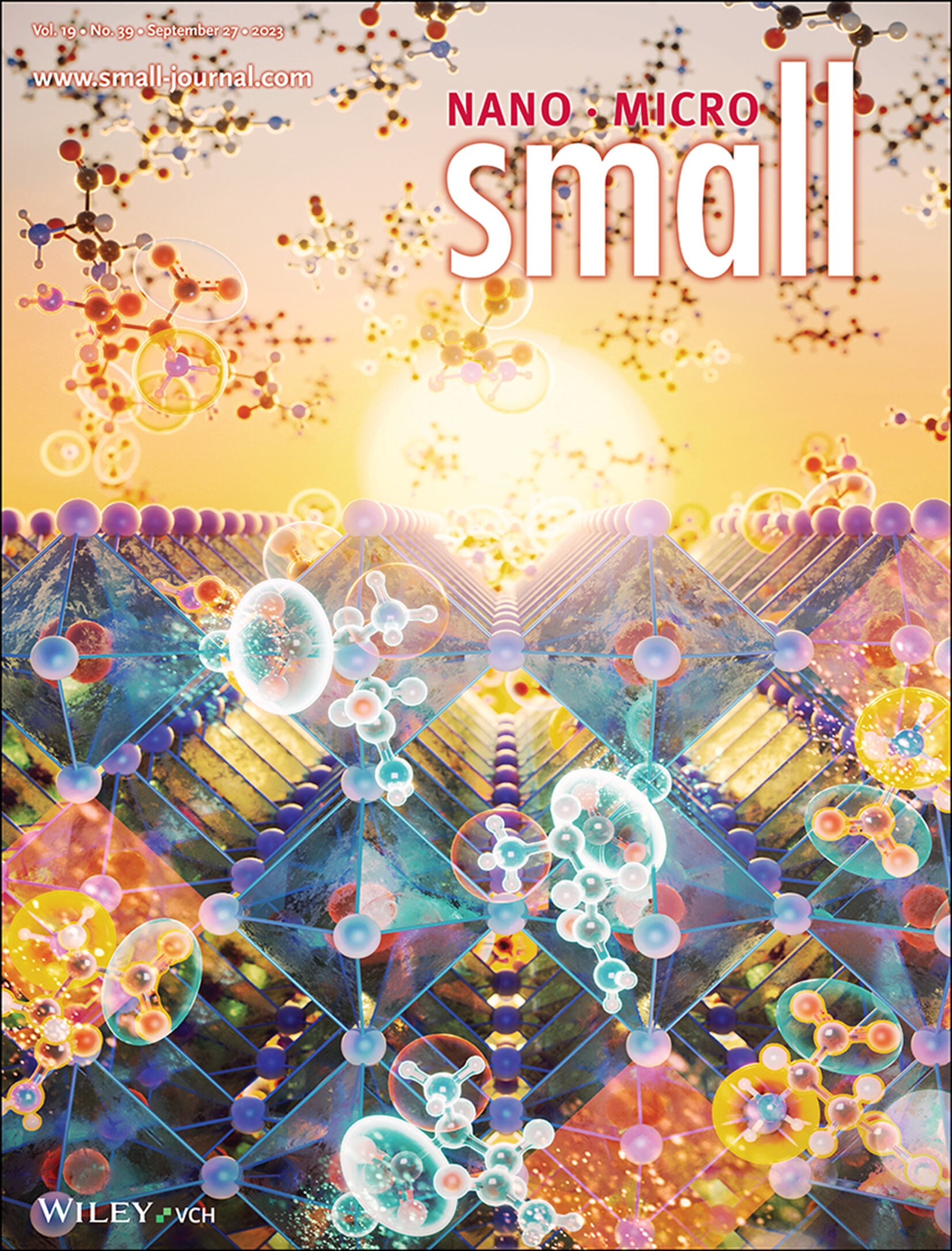
Perovskite Solar Cells
In article number 2302418, Hyungjun Kim, Ki-Ha Hong, Sang Hyuk Im, Chang Eun Song, and co-workers demonstrate a defect-passivation strategy using L-asparagine, which can effectively suppress tin oxidation. L-asparagine as a zwitterion revolutionizes film morphology and energy-level matching, boosting power conversion efficiency to a remarkable 13.31%. Surpassing limitations are tied to tin halide perovskite instability. This work offers transformative insights and practical strategies for advancing tin-based perovskite electronic devices.
Back Cover
Bio-Responsive Macromolecular Drug and Small-Molecular Drug Conjugates: Nanoparticulate Prodrugs for Tumor Microenvironment Heterogeneity Management and Therapeutic Response Enhancement (Small 39/2023)
- First Published: 27 September 2023
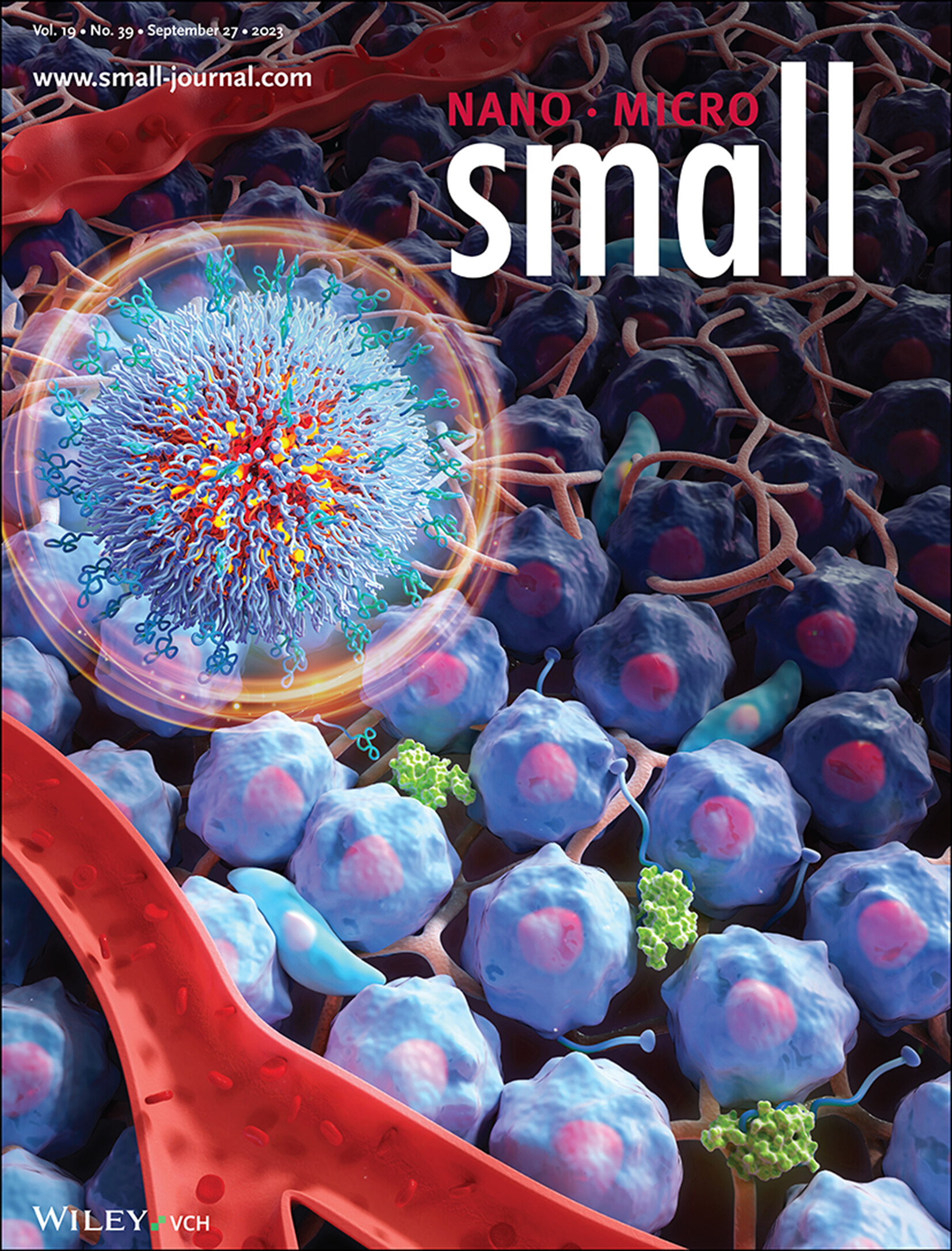
Nanoparticulate Prodrugs
In article number 2301656, Xianghui Xu and co-workers present nanoparticulate prodrugs based on bio-responsive macromolecular drug and small-molecular drug conjugates for tumor microenvironment heterogeneity management and therapeutic response enhancement. This nanomedicine strategy achieves site-specific delivery of macromolecular and small-molecular drugs within tumor tissues, providing efficient management on tumor extracellular matrix, interstitial pressure, vascular network, blood flow, and hypoxia.
Masthead
Reviews
Correlating the Dipolar Interactions Induced Magneto-Viscoelasticity and Thermal Conductivity Enhancements in Nanomagnetic Fluids
- First Published: 28 May 2023
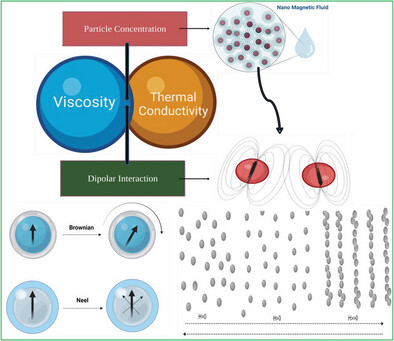
This article explores the potential of nanomagnetic fluids (NMFs) for high performance cooling and biomedical applications. The review focuses on the correlation between the thermal and rheological properties of NMFs, including their stability, ferrohydrodynamic equations, and theoretical and experimental models. The article emphasizes the importance of understanding the relationship between these properties to improve the performance of various systems.
Electrocatalytic Mechanism of Defect in Spinels for Water and Organics Oxidation
- First Published: 31 May 2023

This review focuses on defect spinel electrocatalysts. The applications of defect spinels for oxygen evolution reaction and organics electrooxidation are summarized. The electrocatalytic mechanism and dynamic evolution of defect spinels are demonstrated in detail. Finally, some challenges are provided. This review aims to deepen understanding about structure–activity relationship between defects and activity and provide valuable reference for designing efficient defect electrocatalysts.
Emerging Porous Two-Dimensional Materials: Current Status, Existing Challenges, and Applications
- First Published: 01 June 2023
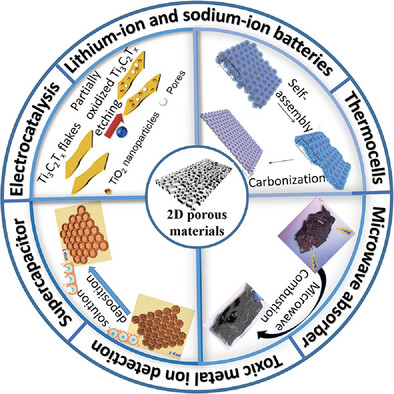
This review provides a summary and discussion on the recent significant progress of porous 2D materials. The synthesis of these porous 2D materials and their corresponding applications are introduced and discussed, followed by a discussion on the challenges in the porous structure of the materials themself, materials synthesis, and future developments of expanding the applications of porous 2D materials.
Frontispiece
Self-Assembly of DNA Nanostructures in Different Cations (Small 39/2023)
- First Published: 27 September 2023
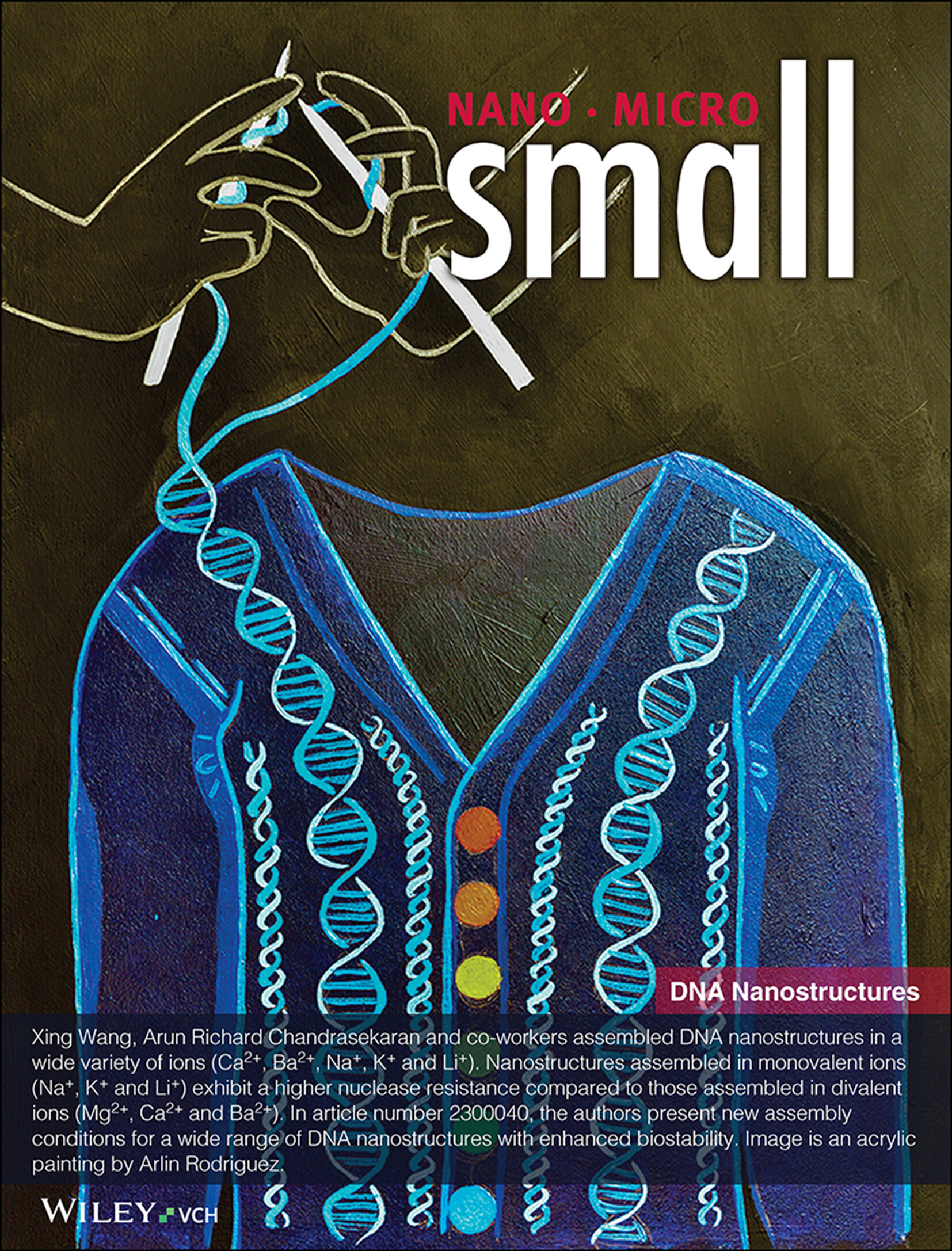
DNA Nanostructures
Xing Wang, Arun Richard Chandrasekaran and co-workers assembled DNA nanostructures in a wide variety of ions (Ca2+, Ba2+, Na+, K+ and Li+). Nanostructures assembled in monovalent ions (Na+, K+ and Li+) exhibit a higher nuclease resistance compared to those assembled in divalent ions (Mg2+, Ca2+ and Ba2+). In article number 2300040, the authors present new assembly conditions for a wide range of DNA nanostructures with enhanced biostability. Image is an acrylic painting by Arlin Rodriguez.
Research Articles
Self-Assembly of DNA Nanostructures in Different Cations
- First Published: 01 June 2023
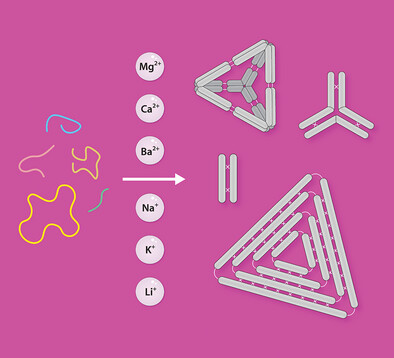
DNA nanostructure assembly typically requires high concentrations of magnesium ions that restricts their applications. Here, the successful assembly of DNA nanostructures in Ca2+, Ba2+, Na+, K+, and Li+ is shown. Structures assembled in monovalent ions exhibit up to a 10-fold higher nuclease resistance compared to those assembled in divalent ions. This study presents new assembly conditions for a wide range of DNA nanostructures with enhanced biostability.
Frontispiece
Liquid Template Assisted Activation for “Egg Puff”-Like Hard Carbon toward High Sodium Storage Performance (Small 39/2023)
- First Published: 27 September 2023
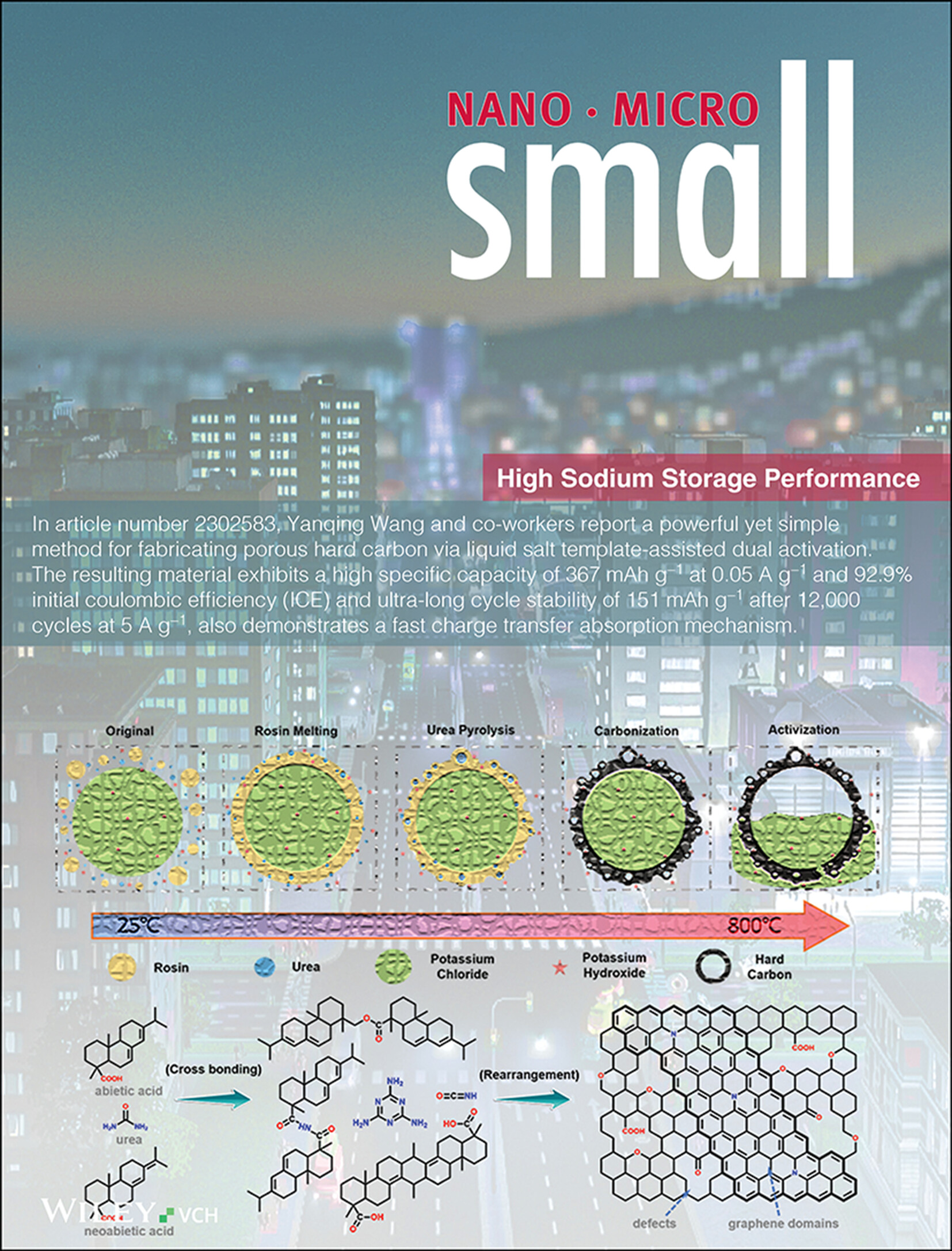
High Sodium Storage Performance
In article number 2302583, Yanqing Wang and co-workers report a powerful yet simple method for fabricating porous hard carbon via liquid salt template-assisted dual activation. The resulting material exhibits a high specific capacity of 367 mAh g−1 at 0.05 A g−1 and 92.9% initial coulombic efficiency (ICE) and ultra-long cycle stability of 151 mAh g−1 after 12,000 cycles at 5 A g−1, also demonstrates a fast charge transfer absorption mechanism.
Research Articles
Liquid Template Assisted Activation for “Egg Puff”-Like Hard Carbon toward High Sodium Storage Performance
- First Published: 26 May 2023
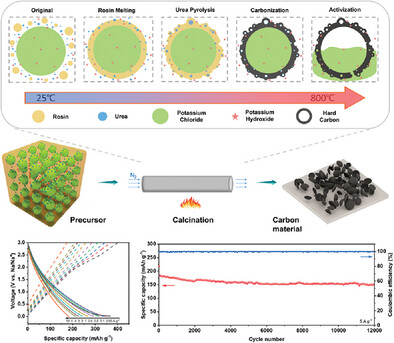
This paper highlights a powerful yet simple method for fabricating "egg puff"-like hard carbon with few N doping via liquid salt template-assisted and potassium hydroxide dual activation. The resulting material exhibits promising electrochemical properties, making it a potential candidate for advanced hard carbon anodes in sodium ion batteries based on fast charge transfer absorption mechanism.
Frontispiece
Cd2Nb2Te4O15: A Novel Pseudo-Aurivillius-Type Tellurite with Unprecedented Nonlinear Optical Properties and Excellent Stability (Small 39/2023)
- First Published: 27 September 2023

Grafting-Assisted Engineering
A new nonlinear optical (NLO) material, Cd2Nb2Te4O15, features a pseudo-Aurivillius-type perovskite layered structure composed of three types of NLO active groups, including CdO6 octahedron, NbO6 octahedron, and TeO4 seesaws, which exhibit a giant cond-harmonic generation (SHG) response, a large band gap, a wide optical transparency window, superior birefringence, high laser-induced damage threshold (LIDT) and strong acid and alkali resistance. More details can be found in article number 2302797 by Guo-Hong Zou and co-workers.
Research Articles
Cd2Nb2Te4O15: A Novel Pseudo-Aurivillius-Type Tellurite with Unprecedented Nonlinear Optical Properties and Excellent Stability
- First Published: 28 May 2023
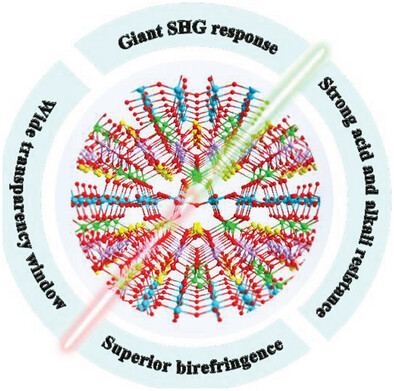
A mid-IR NLO tellurite, Cd2Nb2Te4O15, with the pseudo-Aurivillius-type perovskite layered structure, exhibits the largest SHG effect (31 × KDP) among all reported metal tellurites, a large band gap (3.75 eV), a wide optical transparency window (0.33–14.5 µm), superior birefringence (0.12@ 546 nm), and a high laser-induced damage threshold (23 × AgGaS2).
Frontispiece
Superlithiation Performance of Pyridinium Polymerized Ionic Liquids with Fast Li+ Diffusion Kinetics as Anode Materials for Lithium-Ion Battery (Small 39/2023)
- First Published: 27 September 2023
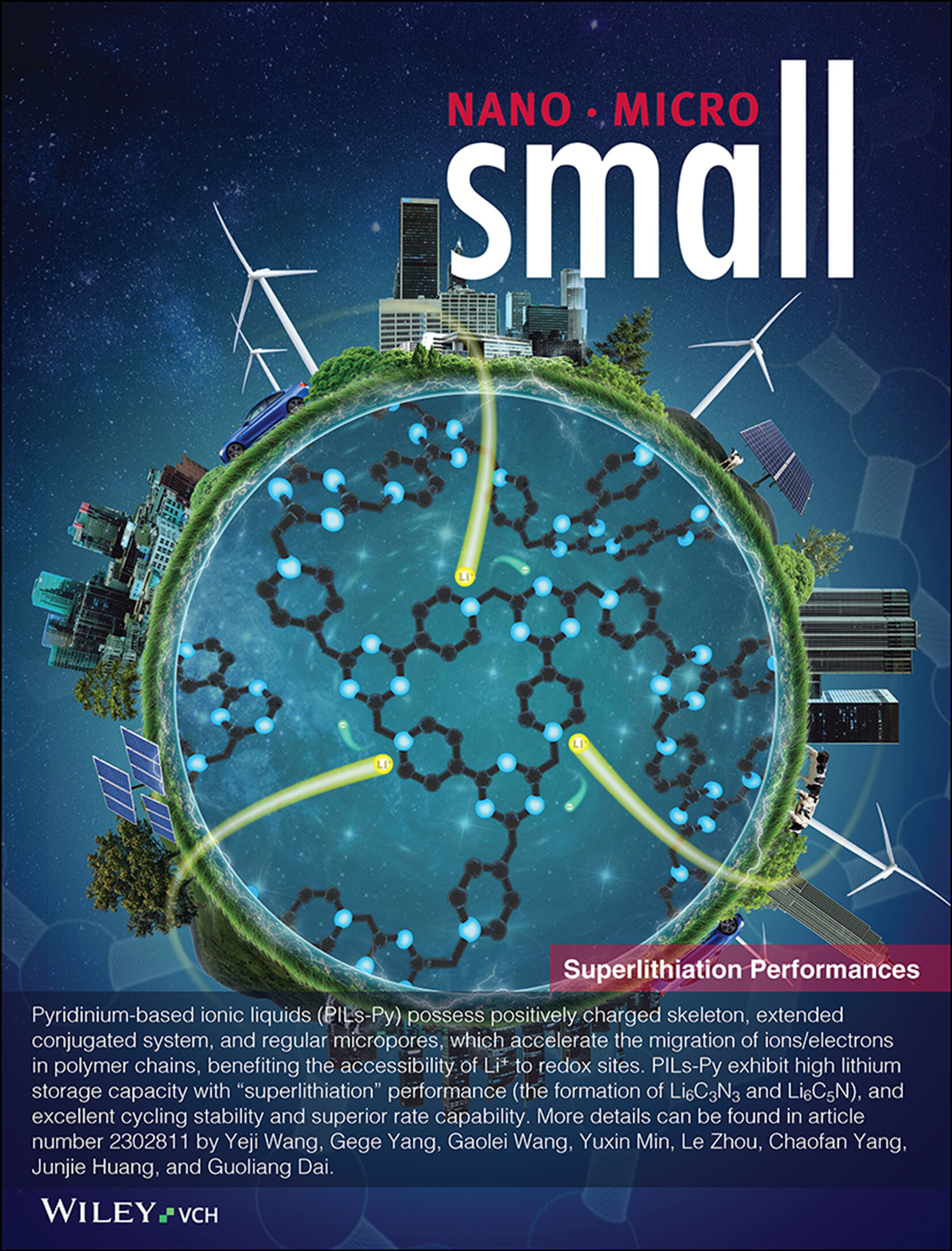
Superlithiation Performances
Pyridinium-based ionic liquids (PILs-Py) possess positively charged skeleton, extended conjugated system, and regular micropores, which accelerate the migration of ions/electrons in polymer chains, benefiting the accessibility of Li+ to redox sites. PILs-Py exhibit high lithium storage capacity with “superlithiation” performance (the formation of Li6C3N3 and Li6C5N), and excellent cycling stability and superior rate capability. More details can be found in article number 2302811 by Yeji Wang, Gege Yang, Gaolei Wang, Yuxin Min, Le Zhou, Chaofan Yang, Junjie Huang, and Guoliang Dai.
Research Articles
Superlithiation Performance of Pyridinium Polymerized Ionic Liquids with Fast Li+ Diffusion Kinetics as Anode Materials for Lithium-Ion Battery
- First Published: 17 May 2023

Pyridinium-based ionic liquids (PILs-Py) possess a positively charged skeleton, extended conjugated system, and regular micropores, which have accelerated the migration of ions/electrons in polymer chains, benefiting the accessibility of Li+ to redox sites. PILs-Py exhibit high lithium storage capacity with superlithiation performance (the formation of Li6C3N3 and Li6C5N), excellent cycling stability, and superior rate capability.
Ultrathin Crystalline Silicon Nano and Micro Membranes with High Areal Density for Low-Cost Flexible Electronics
- First Published: 28 May 2023
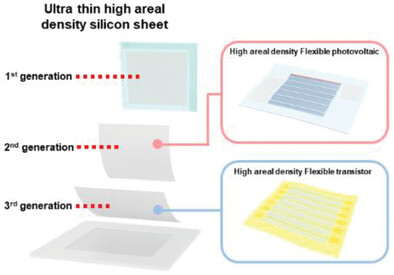
Crystalline silicon nano/micro membrane sheets from a single <111> mother wafer generated by multiple transfer printing method have thicknesses ranging from 300 nm to 13 µm and high areal density of over 90%. Two types of applications (photovoltaic device and transistor array) based on the silicon nano/micro membrane sheets demonstrate applicability in flexible electronics.
Super-Macroporous Lightweight Materials Templated from Bicontinuous Intra-Phase Jammed Emulsion Gels Based on Nanochitin
- First Published: 05 May 2023

Needle-like chitin nanocrystals (ChNC) extracted from crab shells are used to create bicontinuous emulsions via intra-phase jamming, resulting in ultra-lightweight bicontinuous chitin cryogels that displayed a hierarchical porous structure. This work shows the advantage of using sustainable bio-based colloids in complex, non-equilibrium soft materials.
Morphology and Performance Enhancement through the Strong Passivation Effect of Amphoteric Ions in Tin-based Perovskite Solar Cells
- First Published: 26 May 2023
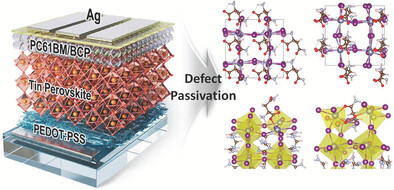
Small amount of amphoteric l-Asparagine additive in tin perovskites effectively passivates the cationic and anionic charged defects and regulates the nucleation/crystallization process in the film as well as prevents the tin oxidation, resulting in improved morphology of the tin perovskite film with a remarkable efficiency of 13.31% and superior operational stability.
Bio-Responsive Macromolecular Drug and Small-Molecular Drug Conjugates: Nanoparticulate Prodrugs for Tumor Microenvironment Heterogeneity Management and Therapeutic Response Enhancement
- First Published: 05 May 2023
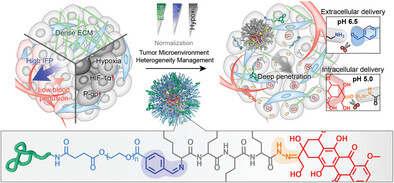
A nanomedicine solution based on dynamic conjugates of macromolecular drugs and small-molecular drugs is designed for tumor microenvironment heterogeneity management and therapeutic response enhancement through programmable multidrug delivery. This work provides a new way to improve anticancer efficiency on drug-resistant and metastatic tumors.
Boron-Doping Induced Electron Delocalization in Fluorophosphate Cathode: Enhanced Na-Ion Diffusivity and Sodium-Ion Full Cell Performance
- First Published: 24 May 2023
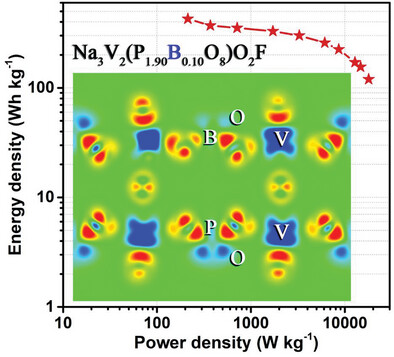
Boron doping at the phosphorus site in Na3V2(PO4)2O2F enables a decrease in bandgap and a delocalization of electron density on the covalently bonded oxygen, which accelerates the electron transfer and reduces the electrostatic resistance imposed on Na+. The obtained Na3V2(P1.90B0.10O8)O2F cathode reveals enhanced Na+ diffusivity, which secures excellent rate and cycling property in half cell, and superior energy/powder density in full cell.
Emergence of a Non-Van der Waals Magnetic Phase in a Van der Waals Ferromagnet
- First Published: 25 May 2023
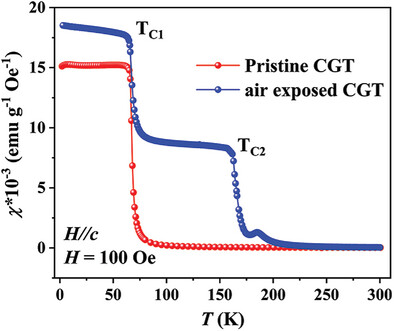
Long exposure to the air triggers the formation of a stable ferromagnetic phase of Cr2Te3 (TC2 ≈160 K) in the parent van der Waals ferromagnetic Cr2Ge2Te6 (TC1 69 K) causing the enhancement of the magnetic anisotropy in the time-elapsed crystal. Air-stable layered magnets having multiple ordering may have applications in low-dimensional nanoelectronics and spintronic devices.
A Transmetalation Synthetic Strategy to Engineer Atomically Dispersed MnN2O2 Electrocatalytic Centers Driving High-Performance LiS Battery
- First Published: 24 May 2023

Highly exposed trans-MnN2O2 sites with high-loading (≈5.02 wt.%) are realized for the MnSA@HNC by an ingenious transmetalation synthetic strategy. Excellent electrochemical performance and theoretical calculation confirm the superiority of unique trans-MnN2O2 sites on prominent affinity and bidirectional SROR activity to LiPSs.
Large-Area Synthesis of Ferromagnetic Fe5−xGeTe2/Graphene van der Waals Heterostructures with Curie Temperature above Room Temperature
- First Published: 25 May 2023
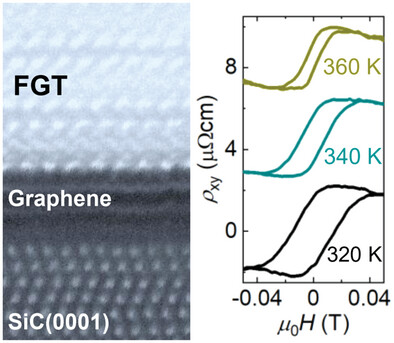
Scalable synthesis of 2D magnetic materials and heterostructures exhibiting a ferromagnetic order above room temperature is a crucial step toward the development of all-2D spintronic devices. Here the bottom-up synthesis of epitaxial Fe5−xGeTe2 (FGT)/graphene van der Waals heterostructures exhibiting a sharp interface between FGT and graphene, and ferromagnetism persisting well above 300 K with a perpendicular magnetic anisotropy, is demonstrated.
Highly N-Doped Fe/Co Phosphide Superstructures for Efficient Water Splitting
- First Published: 25 May 2023

This study provides an all-in-one method for synthesizing binary FeCo phosphides with beneficial N doping (6.4 at%) and 3D hierarchically flower-like superstructure, allowing the simultaneous adjustment of surface property and diffusion behavior inside materials. The N-doped FeCo phosphide delivers very low overpotentials of 132.0 and 270.0 mV to reach current density of 10.0 mA cm-2 for HER and OER, respectively.
Boost of Gas Adsorption Kinetics of Covalent Organic Frameworks via Ionic Liquid Solution Process
- First Published: 25 May 2023
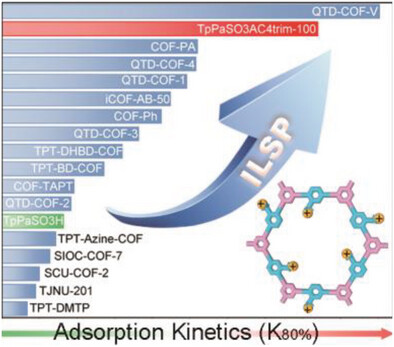
A general post-synthetic method, the ionic liquid solution process (ILSP), is proposed for covalent organic framework (COF) materials. ILSP can significantly improve the gas adsorption performance of COF materials, especially the gas adsorption kinetics. The post-synthesis of TpPaSO3H through ILSP is demonstrated and makes its gas adsorption kinetics K80% value triple improved.
Scalable Bacterial Cellulose-Based Radiative Cooling Materials with Switchable Transparency for Thermal Management and Enhanced Solar Energy Harvesting
- First Published: 25 May 2023
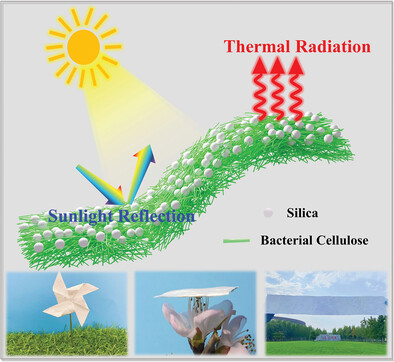
Scalable biosynthetic bacterial cellulose-based radiative cooling (Bio-RC) films with switchable solar transmittance are developed by entangling silica microspheres with continuously secreted cellulose nanofibers during in situ cultivation. The nanostructured Bio-RC film exhibits a high mid-infrared emissivity, radiative cooling, and thermal insulation performance. A significant enhancement of solar power conversion efficiency is achieved in Bio-RC-integrated semi-transparent solar cells.
Electronic Modulation Induced by Ni-VN Heterojunction Reinforces Electrolytic Hydrogen Evolution Coupled with Biomass Upgrade
- First Published: 25 May 2023
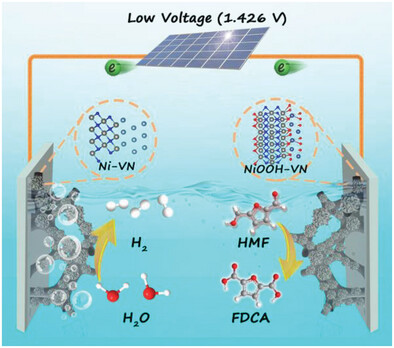
Ni-VN/NF heterojunction is designed as a robust bifunctional electrocatalyst for hydrogen evolution reaction (HER) and 5-hydroxymethylfurfural (HMF) electrooxidation. Ni-VN/NF delivers a compelling HER activity; while, NiOOH-VN/NF derived at anode catalyzes HMF electrooxidation into value-added 2,5-furandicarboxylic acid efficiently. The electrolyzer assembled by Ni-VN/NF merely needs a low voltage of 1.426 V at 10 mA cm−2 for the H2O-HMF paired electrolysis.
Chelate-Capped Nano-AgZn3 Dual Interphase Remodeling the Local Environment for Reversible Dendrite-Free Zinc Anode
- First Published: 24 May 2023
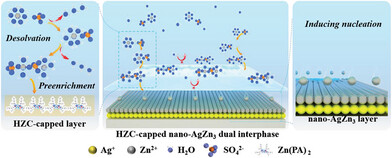
Hydrophobic zinc chelate-capped nano-silver (HZC-Ag) dual interphase is fabricated on the zinc anode surface using an emulsion-replacement strategy. The multifunctional HZC-Ag layer remodels the local electrochemical environment by facilitating the pre-enrichment and de-solvation of zinc ions and inducing homogeneous zinc nucleation, thus resulting in a reversible dendrite-free zinc anode.
Novel Bilayer SnO2 Electron Transport Layers with Atomic Layer Deposition for High-Performance α-FAPbI3 Perovskite Solar Cells
- First Published: 24 May 2023
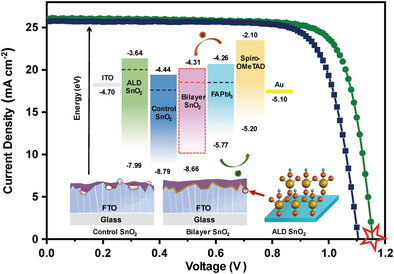
The bilayer SnO2 layers are applied into Perovskite solar cells (PSCs) as prominent electron transport layers (ETLs) successfully addressed the common issues from conventional SnO2 ETL with sol–gel solution. Moreover, the bilayer SnO2 ETLs result in a distinct increase in power conversion efficiency (PCE) and stability of ionic liquid-based PSCs with two-step approach.
Electrochemical Production of Glycolate Fuelled By Polyethylene Terephthalate Plastics with Improved Techno-Economics
- First Published: 25 May 2023
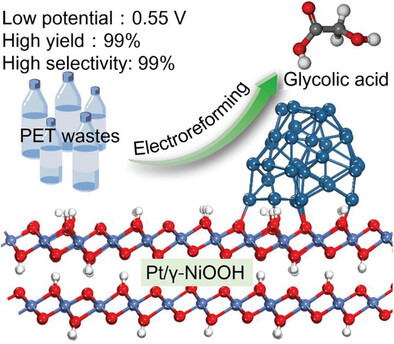
Valorization of polyethylene terephthalate (PET) plastics into commodity chemicals remains an attractive prospect. In this work, the efficient electrooxidation of real-word PET bottles is implemented to high-value glycolate with high Faradaic efficiency and selectivity in alkaline solution under a low applied potential of 0.55 V over Pt-loaded γ-NiOOH nanosheets grown on nickel foam.
Highly Durable Bidirectional Rotary Triboelectric Nanogenerator with a Self-Lubricating Texture and Self-Adapting Contact Synergy for Wearable Applications
- First Published: 28 May 2023
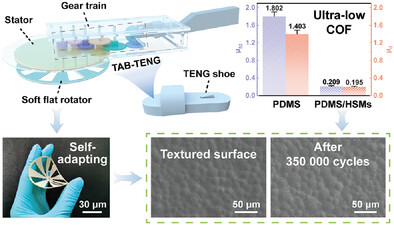
A surface-textured film with self-lubricating anti-friction property is applied to TENGs for the first time to simultaneously reduce the coefficient of friction to an ultra-low value (i.e., 0.195) and improve the electrical output by an order of magnitude. Subsequently, a textured film and self-adapting contact synergized bidirectional rotary TENG (TAB-TENG) is fabricated for wearable applications with remarkable durability.
The Interaction in Electrolyte Additives Accelerates Ion Transport to Achieve High-Energy Non-Aqueous Lithium Metal Batteries
- First Published: 28 May 2023

A liquid electrolyte regulation strategy for inhibiting the side reactions between electrodes and electrolytes is put forward. Through the polymerization of fluoroethylene carbonate and 1-methoxy-2-propylamine, a dense and uniform interface containing LiF and Li3N is generated to prevent the formation of lithium dendrites and the cracking of nickel-rich cathode, which achieves high-stability and high-energy-density lithium metal batteries.
In Situ Construction Channels of Lithium-Ion Fast Transport and Uniform Deposition to Ensure Safe High-Performance Solid Batteries
- First Published: 26 May 2023

Solid-state lithium-ion batteries (SLIBs) eagerly evolve into high energy density and environmental friendliness. In this paper, flexible polymer electrolytes (PEs) generate multiple channels through the matrix to facilitate lithium-ion migration. The Lewis acid centers of organic-modified montmorillonite (OMMT) and the matrix synergize to form and transport more free lithium ions for high-performance lithium-ion batteries (LIBs).
“Dual- Engineering” Strategy to Regulate NH4V4O10 as Cathodes for High-Performance Aqueous Zinc Ion Batteries
- First Published: 26 May 2023
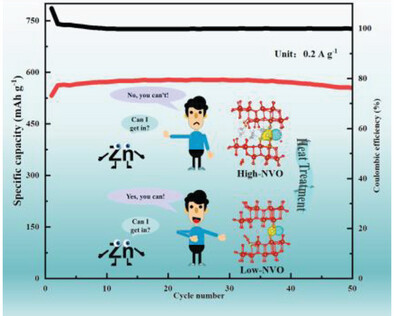
Through a combination of theory and experiment, it is demonstrated that when some of the NH4+ in NH4V4O10 is removed using heat treatment, the remaining NH4+ combined with the pre-inserted Al3+ can effectively improve the charge transfer resistance as well as the diffusion kinetics of Zn2+, which exhibits excellent electrochemical properties (578.2 mAh g–1 at 0.2 A g–1 and 167 mAh g–1 at 10 A g–1).
Uniform Gold Nanostructure Formation via Weakly Adsorbed Gold Films and Thermal Annealing for Reliable Localized Surface Plasmon Resonance-Based Detection of DNase-I
- First Published: 28 May 2023
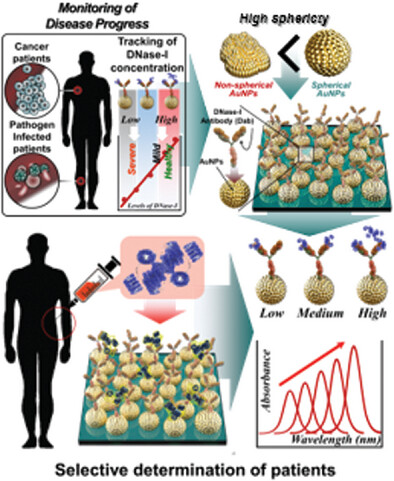
This study presents a novel method, electrochemical deposition, and mild thermal annealing (EDMIT), which is effective in fabricating uniform spherical gold nanoparticles. Mild thermal annealing triggers the rapid restructuring of weakly adsorbed gold nanoislands into spherical nanoparticles via coalescence and Ostwald ripening. The developed platform demonstrates exceptional sensitivity and selectivity in detecting DNASE-1, exhibiting minimal signal variations when analyzed using localized surface plasmon resonance.
Molecular Insertion: A Master Key to Unlock Smart Photoelectric Responses of Covalent Organic Frameworks
- First Published: 26 May 2023

A creative “lock-key model” based on molecular insertion strategy is constructed. Through inserting a guest “key” into the cavity of covalent organic framework (COF) “lock”, an ordered charge transfer network can be established in “lock-key model”. The charge transfer effect enabled the “lock” to be switched on and then stimulating the photoelectric responses of COF host.
Long-Cycling-Life Sodium-Ion Battery Using Binary Metal Sulfide Hybrid Nanocages as Anode
- First Published: 28 May 2023

A binary metal sulfide hybrid consisting of carbon encapsulated CoS/Cu2S nanocages (CoS/Cu2S@C-NC) is syntehsized. The interlocked hetero-architecture filled with conductive carbon accelerates the Na+/e− transfer, leading to improved electrochemical kinetics. The sodium-ion battery (SIB) with CoS/Cu2S@C-NC as anode displays a high capacity of 347.2 mAh g−1 after 2300 cycles at 10.0 A g−1 (≈17 C). The long-cycling-life SIB using binary metal sulfide hybrid as an anode shows promising applications in versatile electronic devices.
Role of Curvature-Sensing Proteins in the Uptake of Nanoparticles with Different Mechanical Properties
- First Published: 26 May 2023
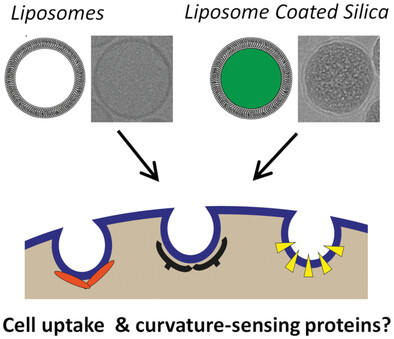
Cells possess proteins capable of sensing and inducing membrane curvature during uptake. Here liposomes and liposome-coated silica are used as a model to compare the role of curvature-sensing proteins in the cellular uptake of nanoparticles with different mechanical properties. Understanding the mechanisms of membrane curvature generation involved in nanoparticle uptake by cells can help to improve nanomedicine efficacy.
Heterostructured Interface Enables Uniform Zinc Deposition for High-Performance Zinc-Ion Batteries
- First Published: 28 May 2023
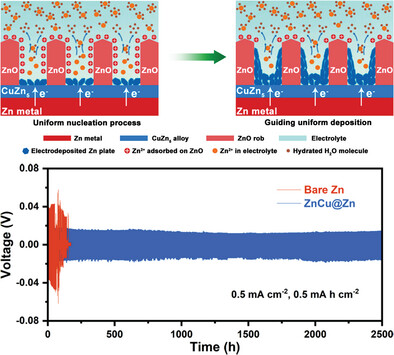
The heterostructured interface composed of ZnO rod array and CuZn5 layer is directly grown on Zn foil. The CuZn5 layer with abundant nucleation sites and the electrostatic attraction effect of ZnO rod array synergistically enable the reversible deposition of Zn. This heterostructured interface with specific functional layers provides a feasible strategy for the design of high-performance metal anodes.
Laser-Driven Transient Phase Oscillations in Individual Spin Crossover Particles
- First Published: 28 May 2023

Spin crossover nanoparticles show length oscillations after exposure to nanosecond laser pulses. The particles undergo repeated transitions between the low- and high-spin state until relaxation in the high-spin state occurs due to energy dissipation. Spin crossover particles are a unique system where a resonant transition between two phases occurs in a phase transformation of first order.
Fracture Toughness Characteristics of Stacked Bilayer Graphene via Far-Field Displacement Measurements
- First Published: 30 May 2023
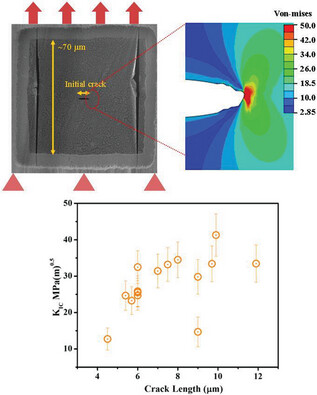
Stacked bilayer graphene sheets (SBLG), obtained via stacking two individual graphene sheets, may serve as the building block for flaw-resilient nanomaterials. Here the first study is reported on the fracture toughness of SBLG. The results suggest that the SBLG is considerably tougher than single layer graphene, potentially to the reduced possibility of co-locating defects at the same planar spot.
Tailoring the Nanoporosity and Photoactivity of Metal–Organic Frameworks With Rigid Dye Modulators for Toluene Purification
- First Published: 30 May 2023

The hierarchically porous MIL-125-NH2 with high crystallinity is prepared by using a micromolar amount of dye-based modulator, which realizes the customization of pore size and avoids the complicated posttreatment. The results of toluene removal in the gas-phase system confirm that the adsorption and photocatalytic activity of hierarchically porous MIL-125-NH2 exhibit simultaneous improvement.
All Resistive Pressure–Temperature Bimodal Sensing E-Skin for Object Classification
- First Published: 31 May 2023

An integrated hierarchical pressure–temperature bimodal sensing E-skin composed of top NiO temperature sensing layer and bottom LIG/SR pressure sensing layer is developed to simultaneously monitor pressure and temperature stimuli. More importantly, a smart glove based on this E-skin enables the achievement of classifying various objects with over 92% accuracy under aid of deep learning.
“Magic Numbers” in Self-Faceting of Alcohol-Doped Emulsion Droplets
- First Published: 31 May 2023
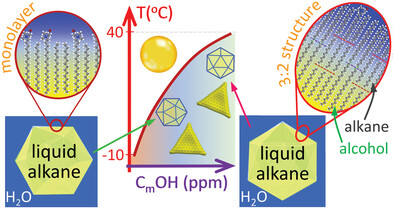
The temperature of counterintuitive spontaneous self-faceting transitions of spherical oil-in-water emulsion droplets increases by >50 °C upon ppm-level doping by alcohols of “magic” chain lengths. This dramatic sensitivity to specific alcohol chain lengths is due to the formation of novel interfacial structures, in which two, three, and even four interfacial alkane layers cocrystallize with hydrogen-bonded alcohol dimers.
LiMgPO4-Coating-Induced Phosphate Shell and Bulk Mg-Doping Enables Stable Ultra-High-Voltage Cycling of LiCoO2 Cathode
- First Published: 31 May 2023
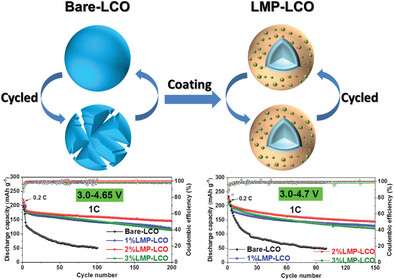
LMP-LCO cathodes with Mg-doping and LMP-LPO coating exhibit stable ultra-high-voltage cycling and high structural reversibility, enhancing capacity retention after long-term cycling. The optimization of both bulk and surface leads to improved interfacial stability, changing the intrinsic electronic structure of LCO cathode materials and affecting their redox reactions. This study provides a new avenue for high-voltage LCO batteries.
An Intelligent Vascular Disrupting Dendritic Nanodevice Incorporating Copper Sulfide Nanoparticles for Immune Modulation-Mediated Combination Tumor Therapy
- First Published: 31 May 2023
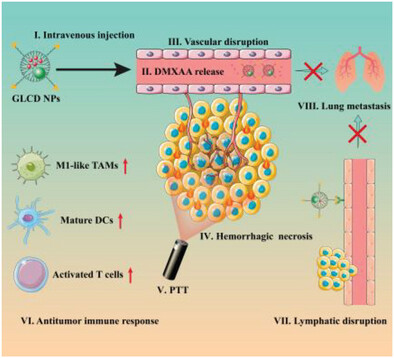
An intelligent dendritic nanodevice incorporated with both copper sulfide nanoparticles and 5,6-dimethylxanthenone-4-acetic acid within the dendrimer internal cavities and surface modified with a targeting agent LyP-1 peptide is developed for immune modulation-mediated combination tumor therapy, simultaneously inhibiting primary tumor growth and tumor metastasis through enhanced photothermal therapy and disruption of both tumor blood vessels and lymphatic vessels.
Thickness-Dependent Superconductivity in a Layered Electride on Silicon
- First Published: 31 May 2023
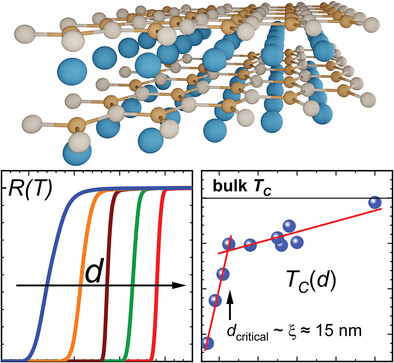
A synthetic route to epitaxial films of layered MAX phases employing Xene-based templates is designed. A set of films of SrAlSi, a layered superconducting electride, is synthesized on silicon. The dependence of the superconducting transition temperature on the film thickness exhibits two regimes; the coherence length serves as the crossover parameter.
Black Ultra-Thin Crystalline Silicon Wafers Reach the 4n2 Absorption Limit–Application to IBC Solar Cells
- First Published: 31 May 2023
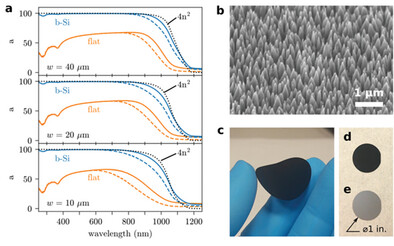
State-of-the-art black-Silicon nanotexture is applied on thin (40, 20 and 10 µm) free-standing wafers, reaching a nearly ideal light trapping. A 40 µm black wafer is further processed into an encapsulated interdigitated-back-contacted solar cell, achieving a 16.4% efficiency and a JSC = 35 mA cm−2, which represents a 43% improvement with respect to a reference polished cell.
NiS/Cd0.6Zn0.4S Schottky Junction Bifunctional Photocatalyst for Sunlight-Driven Highly Selective Catalytic Oxidation of Vanillyl Alcohol Towards Vanillin Coupled with Hydrogen Evolution Reaction
- First Published: 31 May 2023
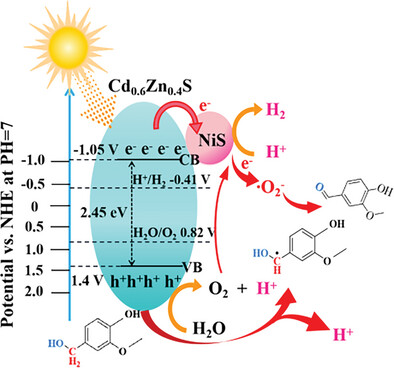
NiS/Cd0.6Zn0.4S Schottky junctions are constructed as bifunctional photocatalysts in which NiS metal enhances the carrier separation/transfer of Cd0.6Zn0.4S, thus boosting the photocatalytic selective oxidation of vanillyl alcohol (VAL) coupling with hydrogen evolution reaction (HER). The present work elucidates the mechanism of selective oxidation of VAL via cleavage of αC–H bond and provides a new pathway towards efficient VAL value-added transformation coupling with HER.
Modulation of p- and n-Type Transitions in Co3−xNixO4 Nanoparticles for Enhanced Supercapacitor Electrochemical Performance
- First Published: 31 May 2023
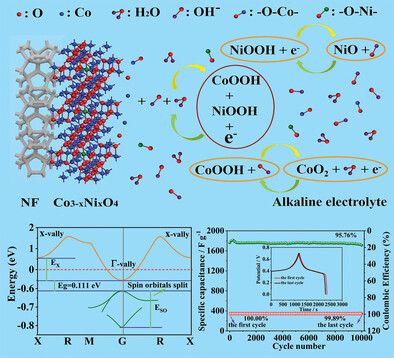
Doping of Ni atoms causes change in the electronic storage mechanism of Co3−xNixO4 electrode material, resulting in different conductive types. After 10 000 cycles, the material exhibits high stability and reversibility. The effective mass of light, heavy holes, and the conductivity mass of the material can be obtained through theoretical calculations, the energy storage characteristics are further studied.
Enhanced CO Affinity on Cu Facilitates CO2 Electroreduction toward Multi-Carbon Products
- First Published: 31 May 2023
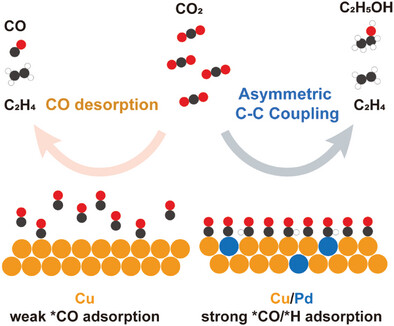
Bimetallic Cu/Pd electrocatalysts exhibit enhanced catalytic performance for electrochemical CO2 reduction reaction. The Faradaic efficiency of multi-carbon (C2+) products for Cu/Pd-1% catalyst reaches a high value of 66.2% at industrial-scale current density. Mechanism investigations illuminate that bimetallic Cu/Pd catalysts with enhanced *CO and *H adsorption achieve efficient CO2-to-C2+ conversion through a promoted *CO*CHO coupling process.
Lung Persistence, Biodegradation, and Elimination of Graphene-Based Materials are Predominantly Size-Dependent and Mediated by Alveolar Phagocytes
- First Published: 01 June 2023
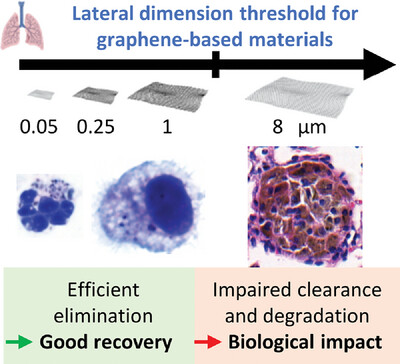
This work highlights the importance of dimensions in the design of safe graphene-based nanomaterials. Decreased thickness leads to increased loading in alveolar macrophages, resulting in slower elimination. Large sheets are internalized with difficulty and are poorly degraded in alveolar phagocytes in comparison to small sheets, resulting in increased tissue damages and long-term persistence in lungs.
Non-Cardiotoxic Tetradecanoic Acid-2,4-Dinitrophenol Ester Nanomicelles in Microneedles Exert Potent Anti-Obesity Effect by Regulating Adipocyte Browning and Lipogenesis
- First Published: 01 June 2023

The amphiphilic tetradecanoic acid-2,4-dinitrophenol ester (TADNP) nanomicelles are developed to enhance 2,4-dinitrophenol (DNP) accumulation in adipose tissues. Additionally, microneedles (MN) patches with excellent biocompatibility are used to transdermally deliver TADNP. MN-delivered TADNP nanomicelles (MN-TADNP) significantly accumulate DNP in adipose tissues and decrease DNP contents in off-target organs. Importantly, MN-TADNP demonstrate promising anti-obesity effects with satisfactory biosafety for obese mice.
Creation of Single Vacancies in hBN with Electron Irradiation
- First Published: 01 June 2023
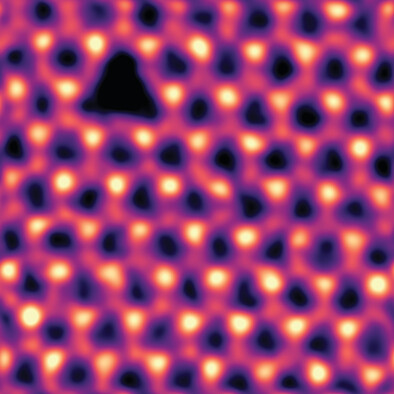
Single nitrogen vacancy created in hexagonal boron nitride by electron irradiation at 60 keV using an ultra-high vacuum scanning transmission electron microscope. In this filtered and colored medium-angle annular dark field image, the nitrogen atoms show brighter contrast than boron due to their greater atomic number, and the vacancy is visible as triangular dark contrast on the top left.
Construction of a Flexible Optogenetic Device for Multisite and Multiregional Optical Stimulation Through Flexible µ-LED Displays on the Cerebral Cortex
- First Published: 01 June 2023
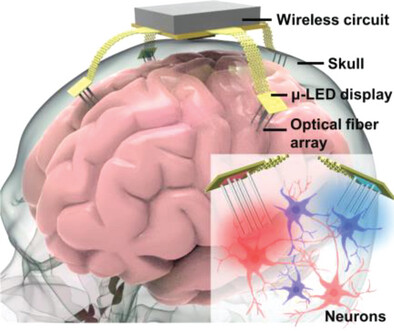
A wireless fully flexible device consisting of multiple high-density μ-LED displays and flexible optical fibers for multisite and multiregional optogenetics is presented. The μ-LED displays feature an ultra-thin morphology with minimized optical crosstalk and can be integrated with stretchable circuits to target different brain regions. The device may serve as a comprehensive platform for sophisticated neuroscience research and clinical applications.
Pt-Pd Nanoalloys Functionalized Mesoporous SnO2 Spheres: Tailored Synthesis, Sensing Mechanism, and Device Integration
- First Published: 01 June 2023
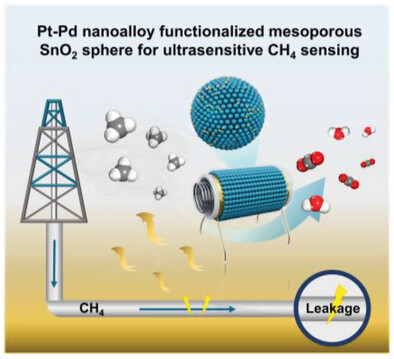
Platinum-palladium nanoalloys functionalized mesoporous SnO2 microspheres (Pt-Pd/SnO2) with high surface area and large mesopore size are elaborately designed. The strong covalent bonding interaction and fast electron transmission between the Pt-Pd nanoalloys and SnO2 support, endow Pt-Pd/SnO2 with satisfied methanesensing properties, providing advanced insights on the construction of high-performance metal oxide gas sensors.
Selective Scatterings of Phonons and Electrons in Defective Half-Heusler Nb1−δCoSb for the Figure of Merit zT > 1
- First Published: 01 June 2023
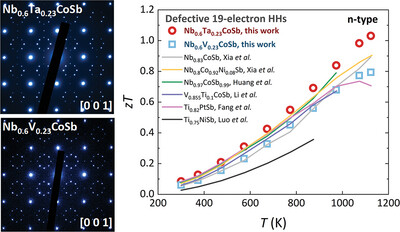
The newly discovered defective 19-electron half-Heusler (HH) compounds feature low lattice thermal conductivity but good electrical properties, desirable in thermoelectric applications. This work realizes the peak figure of merit (zT) exceeding unity in defective 19-electron HHs, making them as competitive as the conventional 18-electron ones.
Oxalate-Assisted Synthesis of Hollow Carbon Nanocage With Fe Single Atoms for Electrochemical CO2 Reduction
- First Published: 01 June 2023
Osmotically Delaminated Silicate Nanosheet-Coated NCM for Ultra-Stable Li+ Storage and Chemical Stability Toward Long-Term Air Exposure
- First Published: 01 June 2023
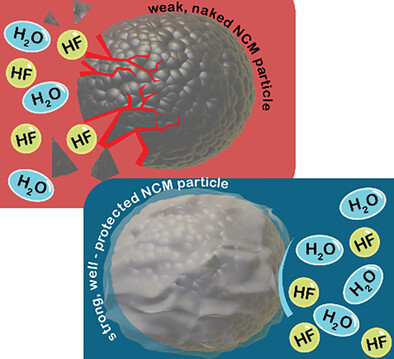
A new coating for lithium-ion batteries (LIBs) is developed from osmotically delaminated sodium fluorohectorite (Hec) nanosheets, which are wrapped around lithium nickel cobalt manganese oxide (NCM) secondary particles. It suppresses mechanical degradation and forms a stable cathode-electrolyte interphase (CEI) layer, resulting in an outstanding capacity retention and maintaining the electrochemical performance of batteries even after 6 months of air exposure.
Fluorinated Interface Engineering toward Controllable Zinc Deposition and Rapid Cation Migration of Aqueous Zn-Ion Batteries
- First Published: 01 June 2023
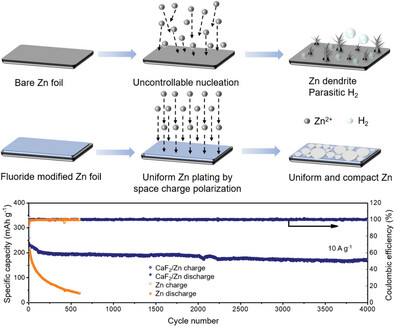
An interfacial engineering strategy is proposed to construct alkaline earth fluoride modified metal Zn electrodes with long lifespan and high capacity retention. The fluoride layer is revealed to guide uniform Zn stripping/plating, accelerate the transfer/diffusion of Zn2+ via Maxwell-Wagner polarization, and act as a compact barrier between Zn electrode and electrolyte to hold back H2 evolution.
Roles of Cobalt-Coordinated Polymeric Perylene Diimide in Hematite Photoanodes for Improved Water Oxidation
- First Published: 01 June 2023
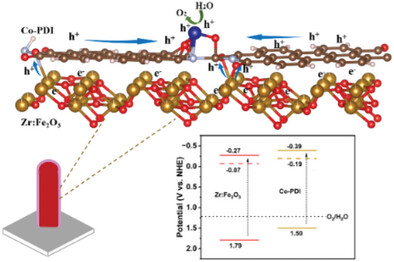
PDI molecules endow the surface dangling Fe atoms of hematite with new chemical bonds and reduce the surface states simultaneously. Besides, the formed bonds between PDI and Zr:Fe2O3 act as charge transfer channels to expedite hole transport at the interface, and the as-established type-II heterojunction accelerate the charge separation. Co2+ is essential to extract and utilize holes for water splitting.
Water-Induced Separation of Polymers from High Nanoparticle-Content Nanocomposite Films
- First Published: 01 June 2023
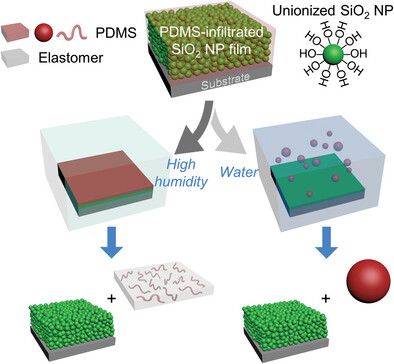
Polymers are spontaneously separated and recovered from high nanoparticle-content nanocomposite films with the aid of water from the vapor or liquid phases. The charge state of nanoparticles plays a significant role in the propensity of water to undergo capillary condensation within the polymer-filled interstitial pores. This work provides insightful guidelines on how to design and fabricate end-of-life recyclable high-performance nanocomposites.
Zinc-Doping Strategy on P2-Type Mn-Based Layered Oxide Cathode for High-Performance Potassium-ion Batteries
- First Published: 10 May 2023
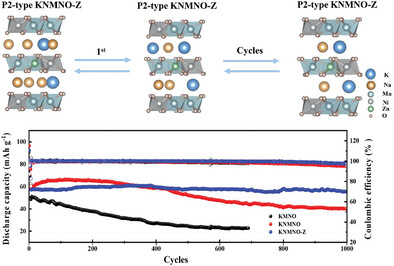
Zinc doping in KNMNO achieves excellent capacity retention, which can be attributed to inhibition of Jahn–Teller distortion and phase separation. KNMNO-Z provides a reversible capacity of 57 mAh g−1 at 100 mA g−1, with a capacity of 97% or more than 1000 cycles, which is beyond most of previous reports on layered transition-metal oxides as PIBs cathodes.
Incorporating Chaotropic/Kosmotropic Chemistries onto Plasmonic Nanoheater to Boost Steam Generation Beyond its Photothermal Property
- First Published: 07 June 2023
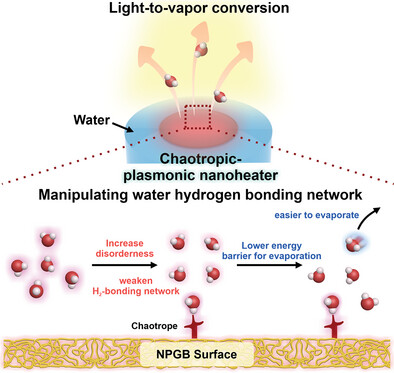
Incorporating chaotropic/kosmotropic surface chemistries on thermoplasmonic nanomaterial directly manipulates water hydrogen bonding network at the point-of-heating. Notably, the chaotropic-plasmonic design disrupts this water network and suppresses the high energy barrier for liquid-to-gas transition. This study thus offers a unique chemistry-based approach to boost steam generation by up to 6-fold faster than emerging photothermal platforms.
MMP9-Responsive Graphene Oxide Quantum Dot-Based Nano-in-Micro Drug Delivery System for Combinatorial Therapy of Choroidal Neovascularization
- First Published: 04 March 2023
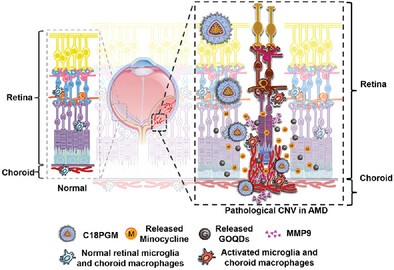
Schematic illustration shows the synthesis of C18PGM (matrix metalloproteinase 9 (MMP9)-responsive graphene oxide quantum dot-based minocycline-loaded nano-in-micro) as a novel drug delivery system for choroidal neovascularization treatment via counteracting inflammation, suppressing MMP9 activity, and ultimately alleviating angiogenic effects.
Porous Host–Guest MOF-Semiconductor Hybrid with Multisites Heterojunctions and Modulable Electronic Band for Selective Photocatalytic CO2 Conversion and H2 Evolution
- First Published: 04 June 2023
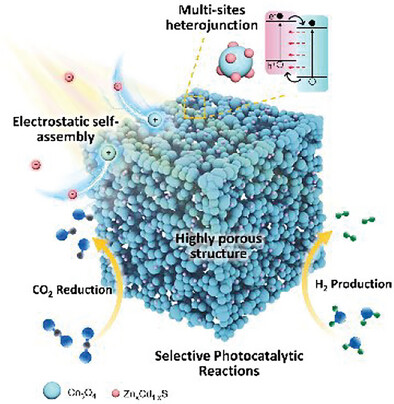
The integration of MOF-derived porous Co3O4 host and ZnxCd1-xS guest with distinct self-assembled hybrid structure and amenable electronic band exhibits remarkable catalytic activity and selectivity for dual photocatalytic CO2 conversion and H2 evolution. Zinc constituent is found to favorably regulate light absorption, conduction band, CO2 absorption, energy of specific reaction intermediates, thus realizing the selectivity control toward CO2 reduction.
Improving Room-Temperature Li-Metal Battery Performance by In Situ Creation of Fast Li+ Transport Pathways in a Polymer-Ceramic Electrolyte
- First Published: 06 June 2023

This work reports a highly conductive and stable composite polymer-ceramic electrolyte for high-energy-density and high-safety solid-state Li-metal batteries. The electrolyte not only exhibits a high Li+ transference number but also significantly improves Li+ transport and lowers contact resistance relative to electrodes. The corresponding Li/LiFePO4 and high-voltage Li/LiNi0.8Mn0.1Co0.1O2 batteries demonstrate excellent cycling performance at room temperature.
Pseudocapacitive Potassium-Ion Intercalation Enabled by Topologically Defective Soft Carbon toward High-Rate, Large-Areal-Capacity, and Low-Temperature Potassium-Ion Batteries
- First Published: 02 June 2023
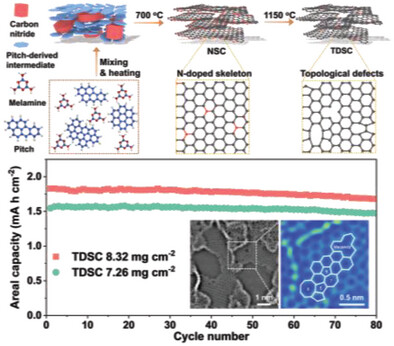
A simple temperature-programmed co-pyrolysis strategy is proposed to fabricate topologically defective soft carbon (TDSC) with excellent rate capability (116 mA h g−1 at 20 C), impressive areal capacity (1.83 mA h cm−2 with a mass loading of 8.32 mg cm−2), long-term cycling stability, and low working temperature (−10 °C).




